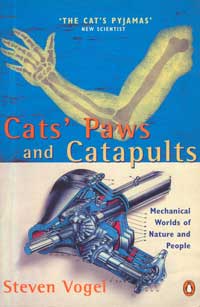
Mechanical Worlds of Nature and People
Steven Vogel
Penguin, London, 1999.
The nub of this book is that,
"We must reject any general notion that nature's ways indicate proper procedures for people. Sometimes nature provides a model; in other instances veneration of the natural is just snake oil for our contemporary troubles." (p.300)
One of the key points is the issue of informational constraints on natural design. (This is the theme of Stewart's book, Life's Other Secret.) The information required to specify the complexity and scope of an adult human is millions of times greater than the 1010 bits stored in sperm or eggs, so natural design must economize.
"Back in 1950 a prescient physicist, Horace B. Crane, predicted that a lot of subcellular structures (he didn't know which) would turn out to be helical in form, not because helices necessarily worked best, but because they could be assembled with especially simple instructions." (p.25)
Buckminster Fuller is disappointingly omitted from so many books on design and architecture, that it is almost a shock to find him discussed in this book. Vogel acknowledges the structural virtues of geodesic domes, although he suggests that the extra labour needed to make suitable panels in "a culture of rectangular lumber and plywood sheets", and the resultant wastes of material, offset the domes' efficiency. Discussing their rarity in nature, he refers back to the point made above:
"One collection of geodesics is usually cited: the protein coats of spherical viruses. Identical protein molecules combine in such coats in just the same numbers - 80, 180, and 320 - as the number of faces in full-sphere geodesic structures. I think, though, that neither mechanical strength nor material economy explains their occurrence. More likely we're glimpsing the shortage of information brought up in Chapter 2. These structures permit a virus to cover itself with multiple copies of a single protein, with each molecule of that protein fitting into an equivalent position, something that can self-assemble with minimal complication." (p.78)
Cats' Paws and Catapults deserves to be read by all designers and readers of science books, and is the sort of book that will be read at least twice: first at enthusiastic speed, then again to dwell on all the fascinating issues that arise. This will in turn lead to the need to get hold of yet more books on related subjects. That being the case, Vogel is kind enough to compensate us with a few pointers on bookshelves:
"Doubling the load doubles the sag. Second, the sag varies with the cube (third power) of the length of the shelf. With the same load, a 36-inch shelf sags 73 percent farther down than a 30-inch shelf. But ordinarily the load itself increases with the length of the shelf since the longer shelf carries more books. So as a practical rule the sag increases with the fourth power of length, and a 36-inch shelf actually sags just over twice as far as a 30-inch one." (p.60)
Be warned.
© Paul Taylor 2000